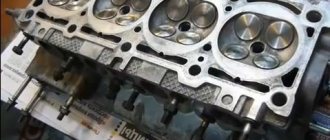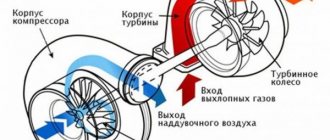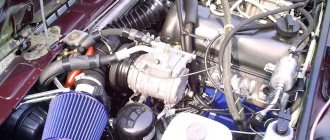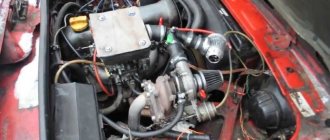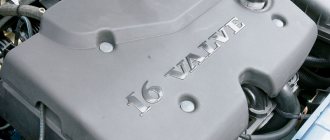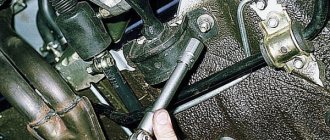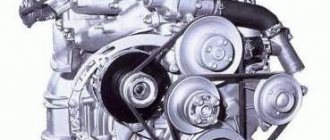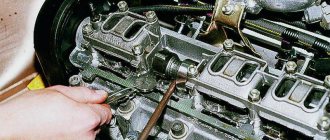Installing a turbine is the most common way to improve the power characteristics of VAZ cars. Atmospheric modification of the engine with a cylinder head bore, a sports exhaust system and sports shafts will be more affordable, but it is limited to a limit of 120-130 hp. Proper turbocharging allows you to remove more than 200 horses from a car. When choosing between turbocharged and naturally aspirated engines, proceed from the tasks assigned to the car. Refinement of the naturally aspirated engine allows you not to get lost in city traffic among more powerful foreign cars. Turbo is better for racing.
In addition, it is almost impossible to legalize a turbo engine in a VAZ in Russia.
Installing a turbo on a VAZ 2114: where to start
Installing a turbine on any car begins with a thorough examination of the hardware. You can’t just go to the store and buy a ready-made kit. And even if it is possible, the system will still have to be modified.
Turbocharged engine VAZ 2114
If you take on this task, consider the following:
- A number of stock units of the VAZ 2114 are unsuitable for a car with a power of over 150 hp. It will not be possible to do without re-equipping the suspension and brakes, installing wider wheels with a turbo engine.
- Tuning foreign cars is partly easier if the model being tuned has “bigger” brothers with turbo engines. Tuning usually comes down to searching, purchasing and adjusting ready-made factory units. It’s more difficult with Togliatti-made cars - VAZs don’t install turbines. Fortunately, in large cities there are tuning studios that develop and produce tuning parts. True, their products are mostly unlicensed, so there will be problems with legalizing changes.
- The correct choice of turbine is the key to successful turbo tuning. Before realizing your dream, we recommend that you read brief descriptions of the turbines used to modify the VAZ.
3 Mechanical air turbocharger - we improve the car with our own hands!
The turbo mode is most effective on injection gasoline engines. Carburetor-type engines can also work with a mechanical supercharger, but they require some do-it-yourself modifications, in particular, the installation of jets with a larger cross-section and other measures. In the case of an injection engine, it all comes down to new firmware.
A mechanical supercharger, powered by the engine crankshaft, has an undoubted advantage - it works absolutely synchronously with the unit and in turbo mode provides a uniform air supply in accordance with engine speed. However, such a device will take away part of the engine power for its operation.
Turbines for VAZ cars
There are many options for installing a turbine on the 2114 model. Theoretically, anything can be adapted, but the following models are best suited for an 8-valve engine:
- Garret 1752;
- Mitsubishi TD04 (installed on Mitsubishi Lancer EVO, Subaru Impreza WRX, and some other models);
- IHI VF10 (this model was equipped with the 1st generation Subaru Legacy cars), as a variant of the VF11-20 (stock for the 2nd generation Legacy);
The list can be expanded with dozens of positions, including more powerful turbines TD05, TD06, VF23-30.
For the first boost we recommend Garret, TD04 or IHI VF10-20. They are widespread, inexpensive and repairable.
Moreover, if there is not enough money for new equipment, it is not difficult to find used kits in decent condition due to the transition of their owners to more powerful equipment
Turbo kit Garret 1752
Turbo kit Garret 1752
Turbines from Garrett are consistently among the most popular among VAZ owners.
Among the reasons for this:
- sold as a ready-made set, there is no need to assemble individual elements using spare parts at car dismantling yards;
- relatively low cost (a new set will cost 30-35 thousand, used ones can be found in the range from 15 to 25 thousand);
- without any special modifications, you can remove the boost from the car to 0.5 bar, increasing power to 120-130 hp. and torque up to 180-200 Nm;
- with additional modifications to the boost system, the boost can be increased to 1 bar, power – up to 170-200 hp, and torque – up to 240 Nm.
The boost kit from Garret is optimal for novice fans of turbo tuning. By setting the boost to 0.5 bar, you can get a good increase in power without reducing engine life. For serious “rides,” this option is not suitable due to its limitations.
Turbines based on the TD04 turbo compressor
Turbine TD04L with actuator
The Mitsubishi TD04 compressor and its various invariants (TD04H, TD04L, TD04HL and others) are one of the most common Japanese turbo systems in Russia. Installed on Mitsubishi Lancer Evolution IV-V generations, turbodiesel Mitsubishi Pajero, as well as many Subaru models of the mid-1990s.
The advantage of this compressor is that in the factory version it made it possible to extract a solid 280 - 340 Nm and 280 hp from 1.6 - 2.0 liter engines. In addition, it is compactly placed under the VAZ hood.
High-performance turbos like the Garret GTX30 (installed on the Toyota Chaser or Mark II and German BMW e39 cars) are more difficult to place under the hood. There are precedents, but doing it on your own is not easy.
The build quality of the Japanese turbine is higher than the Chinese Garrett, and the resource reserve allows you to purchase even well-worn equipment. A distinctive feature of the turbine is its flat torque level. Peak performance varies depending on the type of compressor and additional equipment.
For racing where acceleration is of paramount importance, it is better to consider other turbos. On tracks with long straights, where it is possible to fully use the maximum revs of 4 - 4.5 thousand, the TD04 can compete with more productive models.
Turbines based on IHI VF10 compressor
Turbocharger VF22
Subaru has experimented with turbo engine configurations more than other manufacturers. On the same WRXs you can find Garretts, and the famous Apexi, and Mitsubishi. Not the last place in this series is occupied by the American manufacturer IHI, whose superchargers were installed on legendary cars like the Chevrolet Camaro.
VAZ is equipped with many variants of turbines from IHI, including:
- VF22
- VF23
- VF24
These are classic drag racing turbos that boost extremely quickly, already at 2800-2900 rpm.
The VF10 is less powerful than either of these options. Peak power is about 250 horses (rarely, with very professional tuning and a strong reduction in resource - up to 300). By comparison, the 20th and 30th numbers are capable of developing up to 325 or more horses. But for the VAZ engine, the “ten” (as well as the VF11-20 turbines similar to it), according to many turbo experts, is optimal.
When compared with the TD04 and even the TD05, the VF10 will be faster at the bottom, but the turbo lag will be more noticeable. A VAZ 2114 with such a turbine will feel better on drag or in circuit racing with a minimum of long straights.
Installing a mechanical compressor on an engine: subtleties and nuances
Let's start with the fact that the main task is to select a mechanical supercharger that will meet a number of requirements (weight, dimensions, performance, operating modes, lubrication features, drive design, etc.).
For these purposes, you can purchase a compressor from any car or order a ready-made tuning kit to boost the engine. There have also been cases where the supercharger was made independently, but such home-made solutions are quite rare, especially in the CIS.
The only drawback can be considered the relatively high price of proven offers on the market, while more affordable sets may be of dubious quality and quickly fail.
We should also not forget that more power is achieved by burning more fuel. It is natural that the heat generation in this case also increases greatly, and the motor will require more intensive cooling.
Turbine installation: purchasing parts
Assembling a turbo car is a creative process; much (if not all) depends on the construction kit you assemble.
It is impossible to give unambiguous advice here - all answers are only specific.
In the VAZ store you will need to purchase:
- new pistons (usually Niv ones are used);
- rings (the higher quality the better);
- cylinder head gasket (iron, suitable from Kalina for 8 valves);
- fuel regulator at 2.5-3 bar;
- throttle;
- vacuum tubes, tees, bends, etc.
Simple turbo kit for VAZ 2114
If you buy a ready-made turbo kit, everything is simple. We order and receive. If not, online stores, Japanese car dismantling yards and other e-bay are available. You will need:
- turbocharger (from the above or whichever you like);
- gaskets (pipe, downpipe, oil drain);
- inlet receiver;
- exhaust manifold (there are ready-made solutions for Garrett and TD04; for other turbines you will have to assemble it yourself);
- a set of pipes, clamps and other small things (ready ones available);
- intercooler (you can start without it, it gives an additional increase of up to 10 hp);
- fuel pump (with a capacity of about 250 l/h, the better the quality, the better);
- injectors (budget option - from Volga, more productive - from Subaru or Mitsu Evo);
- blow-off (bypass valve for excess air pressure in the turbine, deserves a separate discussion);
- boost controller (for the VAZ 2114 it is better to use a mechanical one, it is simpler and cheaper, however, you can install an electronic one);
- absolute pressure sensor (ABP), air temperature sensor (ATS), turbine pressure sensor (TP).
The budget can start from 40-45 thousand rubles and tend to infinity, depending on the cost of components and the amount of work performed in the tuning studio.
A little theory
Toyota Sera 1.5 turbo 4WD Serafima Logbook MythBusters FHE connecting rods
Such improvements can be carried out more effectively by those who have a clear understanding of their own actions. To do this you need to understand the theoretical part.
So, the car’s power and fuel consumption depend on the properties and degree of enrichment of the fuel-air mixture entering the cylinders, as well as on its volume.
The fact is that an ordinary engine, when operating, pumps air into itself due to the vacuum created by the piston. In a turbocharged power unit, this work is done by a turbocharger. At the same time, the air is compressed earlier, which allows you to pump in a larger volume. In other words, you can burn a larger volume of fuel. The result is an increase in engine power in relation to engine volume and fuel consumed.
One fundamental point: air, as is clear, heats up under strong compression. Secondly, it will heat up during compression in the combustion chamber. With all this, detonation may occur. And, in addition, due to heating, the air density in the cylinder will decrease, which will naturally reduce the efficiency of the entire system. To remove these bad phenomena, intercoolers are used - air coolers from the turbine. They are a radiator.
As already mentioned, there are two types of compressors:
- A turbocharger that operates by using the energy of exhaust gases. The processed gases enter the impeller and spin it, which is why air is pumped;
- Mechanically driven compressor. It is powered by a motor drive. With all this, efficiency decreases and fuel consumption increases compared to the first version of the compressor, because the mechanical supercharger takes away part of the power from the internal combustion engine.
The entire system, not counting the turbine itself, contains several more fundamental components that need to be kept in mind during installation:
- a control valve that maintains this pressure;
- a bypass valve, which ensures that compressed air returns back to the compressor inlet pipes if the engine throttle valve is closed;
- a bleed valve that releases compressed air into the atmosphere when the throttle valve is closed;
- air pipes;
- oil pipes (serve for lubrication and cooling of the turbine).
Hi all ! In this video I will talk about the design of a turbo engine in our implementation. Enjoy watching.
Refinement and modernization of the carburetor. The main shortcomings of the carburetor injection system and methods for eliminating them, settings. Intake manifold tuning.
Installation: procedure
Turbocharging an engine is a lengthy process. Plans to “turban for vacation” are practically impossible. Plan your time in advance. If the car is your main one, it makes sense to think in advance about purchasing a temporary means of transportation.
Most turbocharging features are unique to different models of compressors and other equipment. The description below is average and schematic.
Stage 1. Preparing the motor . The engine is disassembled, a complete inspection of the cylinders, crankshaft, connecting rods, liners and oil pump is carried out, and the block is polished. Pistons are purchased after preparing the cylinders (boring may be required).
The cylinder head is checked (if necessary, the cylinder head is ground), hydraulic compensators and valves can be used as standard.
Stage 2. Assembly of attachments. New injectors are installed and the fuel pump is replaced. VAZ 2114 engines with 8 valves have a number of advantages compared to 16-valve engines. Firstly, there is no need to be clever with the return. Secondly, it is much easier to connect the fuel pressure regulator.
Next, installation of the receiver, installation of the exhaust manifold, fitting of the turbine. If you purchased an intercooler, we find a place for it and install it. We install piping and blow-offs. We are preparing the oil and cooling supply to the turbine. We remove the air flow sensor and install the DBP and DTV system.
Stage 3. When everything is assembled and secured, there is confidence that nothing is leaking anywhere, the most difficult part begins - setting up. All horsepower, Newton meters and fuel consumption depend on the skill of the tuner. There are good turbo specialists in large cities - do not spare money on their services, otherwise a much larger sum will go down the drain.
A good boost is the result of intellectual work and skill. For the results to justify themselves, remember: there can never be too much information. Study the question thoroughly - the result will amaze you.
Pros and cons of turbine, compressor and naturally aspirated engine
Let's consider all these methods of engine tuning separately.
Turbine
Under the hood of a turbocharged VAZ-2112
In recent years, the installation of turbines on cars of the VAZ family has become quite widespread. And there is nothing unexpected about this, since they are the most common, unlike mechanical inflation (compressor - approx.), because they have a number of advantages.
Firstly, the supercharger is located next to the turbine impeller and is built into the exhaust manifold, driving itself with exhaust gases. Secondly, such an arrangement of components can significantly increase the efficiency of the entire engine, because there is no direct connection between the turbine and the crankshaft, since it does not take power from the engine itself. Experienced auto mechanics call this the main advantage of a turbine over a compressor.
If such designations are difficult for you, in one word, a turbine pumps a lot of pressure into the cylinders and the higher it is, the greater the power.
Turbine disadvantages
However, the turbine has its drawbacks, and these include “turbo lag”. This effect manifests itself in a slow response to pressing the gas pedal, and at low speeds the turbine operation will not be felt at all. The explanation for this is very simple: in order for the engine to begin to gain power and speed, it requires time for the exhaust gas pressure to increase, which would be able to properly spin the turbine. For exactly the same reason, a turbocharged engine is capable of producing maximum power only after 4000 rpm.
Compressor
The compressor engine starts air movement due to a special mechanical supercharger operating using a belt drive. That is, the operation and power of the engine directly depends on the number of revolutions gained and the higher they are, the higher the power. In the design of the compressor, the air mixture with fuel is not only supplied to the cylinders under pressure, but is also capable of blowing through the exhaust and intake valves when they are not completely closed, thereby cleaning them. Because of this design, the engine is always able to operate at full power.
Disadvantages of the compressor
A significant disadvantage of such a modification is the unreliability of the drive belts, which will one way or another break and become unusable, as well as increased fuel consumption, since the compressor is best installed on engines with a large volume, since the efficiency of interaction with them will be much higher.
Atmospheric engine
When talking about an atmospheric engine, many people think of anything but what actually exists.
An atmospheric engine is a regular engine that does not have any supercharging, that is, turbocharged or compressor. However, there are some nuances here too.
The atmospheric engine is both simple and the most complex in its design. Since the ideal fuel-air mixture is supplied to the cylinders of this engine, without any obstacles or resistance in its path. The manifold works perfectly on this engine, the camshaft is adjusted as precisely as possible, the cylinder diameter, piston stroke, and so on are increased. And all this is done to increase the rated power of the engine.
Despite the fact that this is a seemingly ideally built engine, the advantages of which include the strictly accurate response of the gas pedal and a good reserve of power at any speed, it also has disadvantages in comparison with its turbocharged counterpart.
Cons of a naturally aspirated engine
- The first disadvantage due to which you can give preference to the “turbo” is the very high fuel consumption and the high degree of wear of the internal parts of the engine. It is also impossible for a naturally aspirated engine to more than double the stock power, whereas a turbocharged engine can increase it several times.
- Heavily promoted “aspirated” engines only drive at high speeds, which has a negative effect when driving in urban conditions. They also have a high idle threshold, which is also inconvenient for everyday use.
As you can see, all three types of engines have their advantages and disadvantages, but today we will focus on the turbine , since this is the most suitable type of tuning for the VAZ-2112 engine.
